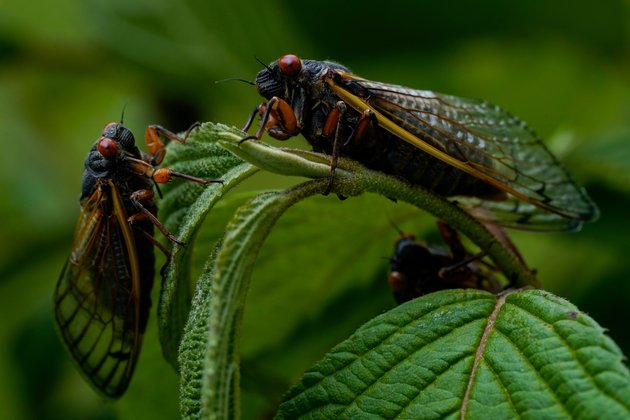
Billions, perhaps even trillions, of cicadas are emerging from the soil over a six-week period in more than a dozen U.S. states. The Washington region, including Northern Virginia, is a hot spot for the plentiful but short-lived thumb-sized insect that some find fascinating and others unnerving.
Entomologist Floyd Shockley searched a wooded area in Alexandria, Virginia, for the harmless insects, which slowly climb out of the ground every 17 years from under the deciduous trees on which they feed.
“There’s a couple of adults over here,” Shockley said as he gently picked up a black creature with translucent wings and prominent red eyes. Shockley is the collections manager at the Smithsonian National Museum of Natural History in Washington. Today, he is collecting specimens for research.
More than 3,000 kinds of cicadas can be found worldwide. While many appear annually, some U.S. varieties spring from the ground either every 17 or 13 years. The cicadas currently blanketing the Washington area are known as Brood X (10).
“It’s an amazing phenomenon,” Shockley said.
Two-year-old Robert Cody in Alexandria can’t get enough of the cicadas, even when they fly and land on him. “The cicadas are my friends. They tickle my ears, and their eyes look like fire,” he said.
Some people are wary of the bugs, like Jeremy Buchanan in Herndon, Virginia, who likes to take a run after work. “When I run by some trees, they sometimes drop on my head,” he said.
“There’s no reason for people to be afraid of them,” explained Gene Kritsky, a cicada expert at Mount St. Joseph University in Cincinnati, Ohio. “They don’t bite or sting or spread diseases on crops.”
Kritsky came up with the idea of a phone app and website called Cicada Safari that citizen scientists can use to post their cicada photos and the location where they were taken.
The Brood X cicadas came into being in 2004. After 17 years underground, they emerged when soil temperatures reached 18 degrees Celsius. Light brown male nymphs emerge first, shedding their exoskeletons and unfurling their wings as they climb up nearby trees. Within a week, the females follow suit.
“They come out for one reason, and that is to mate and keep the population going,” explained Stuart McKamey, a leading cicada expert with the U.S. Department of Agriculture’s Systematic Entomology Laboratory.
“The secret is to come out in great numbers to overwhelm their predators, which include birds, mammals and reptiles,” added Kritsky. “Even if a million of them are eaten, there’s still many more left.”
Since the protein-rich cicadas aren’t poisonous, adventurous humans can eat them as well. A cookbook called Cicada-Licious includes recipes for cicada pizza, tacos and cookies.
Brian Schwatken in Arlington, Virginia, fried some cicada nymphs with butter, garlic and onions. “They are tender, have kind of a nutty taste and are really good,” he said.
The males court the females with a screaming high-pitched mating call that resembles the droning sound of a UFO in an old movie, Shockley said. A chorus of cicadas can be louder than the sounds near an airport when jets are landing, Kritsky added.
The females don’t fall for just any male. He must win her over by showcasing his different tones and rhythms. If she’s interested in him, she clicks her wings, McKamey said.
Adult cicadas die soon after mating and fertilize the soil.
The females lay their eggs on small branches. After they hatch in about six weeks, tiny white nymphs fall from the trees and burrow into the soil, repeating the 17-year natural wonder all over again.
Kritsky said it’s a “big mystery” how the cicadas time the 17-year cycle. Underground, they feed on the sap of deciduous tree roots, stopping during the winter and beginning again in the spring. It could be the insects detect the trees’ seasonal changes, Shockley said.
•Text (excluding headline) courtesy of VOA.









local dating sites for free
dating profile examples for women
over 50 dating singles
ukraine dating
gay chubs dating
gay speed dating pittsburgh
gay dating black
gay dating in houston
phone dating gay
dating a virgo gay man
gay speed dating las vegas
dating a dutch guy gay
free gay mature dating site
lds gay dating
korean gay dating sites
the league dating site gay
teenage gay dating
gay dating site in san antonio
gay dating washington dc
gay dating site like tinder
gay teen dating websites
gay dating phobe chat
one man gay dating site
gay bear dating online free
gay dating website india
dating sites gay
best gay dating sites 2021
gay dating websites 2021
tinder gay dating
gay dating blog
gay dating in dallas texas
dating gay teen
best online dating site gay men
very gay dating
9414470931 gay dating
millionaire gay dating
new gay dating
cheap custom essay writing services
cheap custom essay writing services
australian essay writing service
mla essay
words to conclude an essay
free essay writing
sex games cancun sara blake
loli sex games
total drama sex games
date games sex
lesbian shower sex games
sex games creampie expansion
illusion games sex in a
free android sex games
free sex games android
online 3d sex games
money talks sex games
sex and porn games
keto boost
keto syrup
avocado keto
keto vegan
list of keto foods
how to do keto diet
classification essay
write an essay for me
writing about yourself essay
cyberghost vpn free download
opera vpn
best vpn multiple devices
evaluation essay topics
summary essay example
sat essay
gay masturbation live chat
gay chat avenue
arab friends gay webcam chat
what does a vpn do
tunnelbear vpn free
best vpn for dark web
what is critical thinking process
critical thinking problem
critical thinking elements
an example of critical thinking
bloom’s taxonomy critical thinking
critical thinking defined
characteristics of critical thinking
critical thinking com
common barriers to critical thinking
essay paraphraser
how to write a reflective essay
essay checker free
informative essay
how to write conclusion of essay
introduce yourself essay
atlanta gay phone chat
gay porn chat random
gay chat mesa az
masters dissertation help in india
dissertation writing tutors
proposal and dissertation help nursing